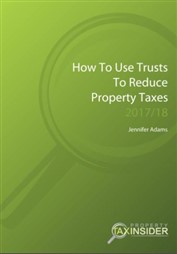

Capital Gains Tax (CGT) is charged in the following situations, the exact circumstances of which determine who is liable for the CGT, if due.
- On creation of the trust and/or transfer of assets into the trust – the settlor is treated as having disposed of the asset to the trust as a gift and be liable for any tax that may be charged. The asset is transferred at the ‘market value’ at the date of transfer. The ‘market value’ rule applies because the settlor and trust are deemed to be ‘connected’. However, it may be possible for the settlor to defer (‘hold over’) the charge (see section 3.3).
- Sale or transfer of property out of the trust – the trust is liable to CGT under the usual CGT rules, subject to the annual exemption for trusts, which is half of the allowance for an individual at £5,650 for 2017/18 for most trusts. The trust rate on any gains is 20 per cent for 2017/18 unless the gain is on the sale or transfer of property where the rate is 28 per cent.
- Emigration of the trust – should the trustees emigrate such that they are no longer resident in the UK and therefore no longer UK taxpayers, then the trust will be liable for a CGT charge based on the 'market value’ of the property at the date of emigration.
Amount Payable And Date
If there is a CGT charge on creation of the trust then it will be payable by the settlor after deduction of the annual exempt amount for an individual (£11,300 for 2017/18), payable on 31 January following the end of the tax year in which the transfer took place.
Should the trust have been created on death, no CGT is charged on the transfer of the assets into the trust. In addition, for the purposes of any later CGT liability, the acquisition cost by the trust is deemed to be the value at the date of death, thereby creating a ‘tax-free uplift’ in the base cost of the asset.
Any CGT due on property transfer or emigration is calculated after deduction of the annual exempt amount for trusts and taxed at 18 per cent (20 per cent if the transfer is of residential property), payable by the usual payment date of 31 January following the end of the tax year of the event.
Planning To Reduce The CGT Bill
Any CGT due on a chargeable gain made on the sale of an asset by the trust itself can be reduced for both types of trust by use of the following:
- Losses — losses incurred on the sale of assets held by the trust can be offset against any gains made in the same tax year, thereby reducing the total amount of chargeable gains made. However, it should be noted that there are anti-avoidance rules preventing offset in specific circumstances (not covered in this guide).
- ‘Hold over’ relief claim – this is an important relief for CGT purposes as it effectively allows a chargeable gain to be deferred (‘held over') and passed on to the recipient of the gift — in this case, the trust itself. The settlor must be UK resident for this relief to be claimed. The CGT charge is deferred until the asset is eventually sold. Therefore, CGT will be charged on the increase in value from the date of transfer into trust and the final sale proceeds as usual, but the CGT ‘hold over’ amount will be added to the final amount payable. Broadly, where trusts are involved, ‘hold-over’ relief is only available on any transfer that gives rise to an inheritance tax liability (such as a gift of property into a 'discretionary' trust) or on the transfer of business assets.
CGT On The Cessation Of A Trust
A ‘QIIP’ trust ends when the beneficiary becomes ‘absolutely entitled’ to the trust property, which will either be on death or when some special condition contained in the Trust Deed is met (e.g. when the beneficiary reaches a specified age, say, eighteen years). Being ‘absolutely entitled’ means that the beneficiary can direct the trustees as to what to do and how to deal with the assets; he may even require the assets to be transferred to him.
When a trust ends in this way, no CGT is due (but neither are any capital losses allowable). The trust is deemed to have disposed of the assets held at the date that the special condition is met and then to immediately re-acquire at market value.
The trust still holds the assets, but as nominees or ‘Bare trustees’ until either the asset is subsequently sold or is finally transferred to the beneficiary. A subsequent disposal will then be treated as a disposal by the beneficiary. Thus a chargeable gain will only arise if the cost of the asset had been reduced by a ‘hold over’ relief claim on the original transfer into the trust and if so, the CGT gain will equal this ‘hold over’ amount. Since a transfer of an asset to a beneficiary who already has an interest in possession in the asset does not attract inheritance tax, no further ‘hold-over relief’ is available unless the property is deemed to be a business asset.
Should a life interest in a trust terminate other than on the death of the beneficiary (e.g. because a widow remarries or the interest is transferred to someone else), then as the asset remains within the trust and the trust continues there will normally be no CGT implications and the base value of the asset will remain the same for future CGT disposals.
Should a ‘Discretionary’ trust cease, the CGT position is the same as for a ‘QIIP’ trust except that ‘hold-over’ relief will generally be available as the transfer will come with the scope of inheritance tax.
A Problem Linked To Principal Private Residence Relief (PPR)
A beneficiary can occupy a property held within a trust as their main residence and the future disposal of the property by the trustees may qualify for some PPR relief depending upon the date of creation of the trust. However, generally, trusts and PPR do not work well together because once a transfer of the property has been made into a trust and a ‘hold over’ election made, (which will be needed to ensure that a CGT charge is not immediately payable), then HMRC will deny PPR on any subsequent sale. This holds true whether the trust subsequently sells the property or the property is transferred out of the trust and the beneficiary as transferee then sells.
Should a property have been subject to a ‘hold over’ election post 10 December 2003, PPR relief is not available until after it has been sold to a third party. If the original transfer took place before 10 December 2003, PPR relief is only available on the proportion of gain arising before that date.
So the choice is broadly between paying CGT at the date of transfer into the trust based on the ‘market value’ (claiming PPR relief on any future sale, if relevant) or ‘holding over’ the gain using the trust, but being aware that the full gain will be chargeable to CGT on the final sale, CGT being charged at 28 per cent.
Practical Tip
Consider not electing for ‘hold over’ relief on the original transfer. Rather, opt to pay the CGT sooner rather than later, especially if it is thought that CGT rates are likely to rise in the future. Not electing would also be beneficial should any gain be covered by an available annual exemption or sheltered by capital losses. The tax and law issues affecting ‘hold over’ and trusts are potentially complex and as such specific professional advice should always be sought. This is a sample extract from the report ‘How to Use Trusts to Reduce Property Taxes’ published by TaxInsider.co.uk.
This is a sample extract from the report ‘How to Use Trusts to Reduce Property Taxes’ published by TaxInsider.co.uk.



Please register or log in to add comments.
There are not comments added